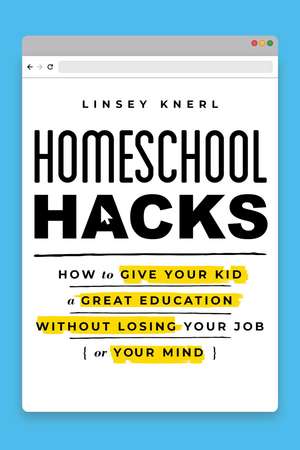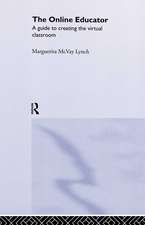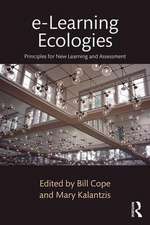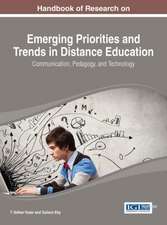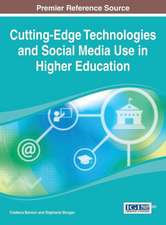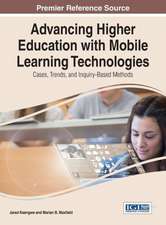Homeschool Hacks: How to Give Your Kid a Great Education Without Losing Your Job (or Your Mind)
Autor Linsey Knerlen Limba Engleză Paperback – 12 mai 2021
As kids across the country start the school year on Zoom—and possibly finish it there, too—more and more parents are wondering if homeschooling is the answer. But many fear they won’t be able to juggle it on top of their own jobs and obligations. Luckily, Linsey Knerl is here to help. As a mother of six and freelance journalist whose own children learn at home, she’s committed to making homeschool work for every family who wants it.
In Homeschool Hacks, she shares stories of homeschooling families with different backgrounds and motivations, dispelling the myth that it’s only for religious folks or stay-at-home parents. And she walks you through a complete plan for your child’s learning, including:
-Sample schedules to create a flexible framework for your own classroom
-Curriculum assessments to discern which program will best fit their needs and their schedules
-Tips for finding—and navigating—your local the homeschool community
-Online resources to continue your journey through graduation
Whether you are considering homeschooling for the long term, the short term, or the first time, this book has everything you need to become your kids’ best teacher ever.
Preț: 115.84 lei
Nou
Puncte Express: 174
Preț estimativ în valută:
22.17€ • 23.70$ • 18.48£
22.17€ • 23.70$ • 18.48£
Carte disponibilă
Livrare economică 27 martie-10 aprilie
Livrare express 12-18 martie pentru 25.88 lei
Preluare comenzi: 021 569.72.76
Specificații
ISBN-13: 9781982171155
ISBN-10: 1982171154
Pagini: 240
Dimensiuni: 152 x 229 x 18 mm
Greutate: 0.39 kg
Editura: S&S/Simon Element
Colecția S&S/Simon Element
ISBN-10: 1982171154
Pagini: 240
Dimensiuni: 152 x 229 x 18 mm
Greutate: 0.39 kg
Editura: S&S/Simon Element
Colecția S&S/Simon Element
Notă biografică
Linsey Knerl is a mom of six who has been homeschooling since 2004. Her interest in small business and entrepreneurship led to a freelance writing career that complimented her own homeschool style. Linsey has been a trusted source for families since 2008. Her tips for budgeting have appeared in various publications, including Time, Shape, Better Homes & Gardens, Reader’s Digest, Family Circle, All You, and Woman’s World. Her media company (Knerl Family Media) has grown to include her better half in life and business, Sam. Together Sam and Linsey work to educate and support their growing family.
Extras
How Do You Start?
Throughout the more than fifteen years that I’ve been homeschooling my six kids, I’ve gotten many questions from family and friends. Some are hoping to sniff out inadequacies in my methods or catch me in the act of not knowing what I’m doing. Others are honestly looking for answers. But I tell them all the same thing.
My goal is to give you enough step-by-step, actionable information to be able to start homeschooling tomorrow morning, if you wish. But before I explain exactly how it’s done, I ask that you keep in mind one vital truth as you read this book (and any others you may have sitting on your shelf).
It probably won’t be like you think.
Remember the first time you tried to feed your baby solid food? You were so excited that you spent hours in the gourmet baby food aisle, choosing between organic peas or a lovely sweet potato–prune mix. You purchased the ergonomic-handled spoon, a bib that catches crumbs at the bottom, and the most versatile high chair on the market.
How do you feed your baby? It’s easy, you think. Open the jar, scoop up some puree, and place the food in the infant’s open mouth.
What could be simpler?
And then you try it. The puree is runnier than you thought; it dribbles down your hand and arm, leaving little on the spoon for the baby, who has shut her tiny mouth well before you get there anyway. Now the game has changed. All those “simple” directions still matter, but you must improvise your way from one step to the next. Singing a song to get your baby to smile so you can sneak a spoonful of puree in before he realizes what’s happening and spits it all out onto his new bib? That’s the truth that won’t be completely covered in the book. That’s the part that will require intuition, trust, and patience.
You are a parent. You have instincts, and you know your child better than anyone. That’s the true advantage to you as a teacher, and why homeschooling can work so beautifully when done correctly. Every other homeschool parent has managed to fill in these gaps, and you will, too.
How? I abide by two rules when trying to brainstorm ways to get through these in-between steps:
1. We can try any methods possible if they’re legal, safe, and follow the values of my family.
2. If the children are moving forward, they’re learning, and homeschooling is considered a success.
If those seem vague or allow for too much flexibility, think back to those first few bites of baby food. I wasn’t in your kitchen at the time, so I can’t see if you played Taylor Swift or stood on your head or ate half a jar yourself to set an example. But if your methods followed rule number one and led to rule number two, you did a fine job. And that’s how homeschooling will work.
The First Steps to Starting Your Homeschool
Now that you can relax a bit, knowing that you have what it takes to parent your child through a quality education, what to do first? Since education is largely localized, your state and district requirements will be unique. The paperwork needed to homeschool in upstate New York, for example, will be quite different from what it takes to get started in Nebraska. From there, however, the methods are generally the same.
1. Research the Requirements for Your State
Start this process now, even if you aren’t sure you want to start homeschooling until next year. Some states have a lot of hoops to jump through, paperwork to fill out, and permissions to grant. If you live in one of these states, it can take months to get from the research phase to your child’s very first day in their homeschool environment. Make sure you’re researching the most up-to-date information for your state as well, since laws change often. (Be sure to check out Chapter 3, with even more information on the legalities of homeschooling. Parents who share custody or who have unique family situations may need to reach out to an expert for legal advice.)
Where can you go for help? Home education support groups are the best way, and these can be found online through social media groups, websites, and sometimes even your state Department of Education. Find someone who has homeschooled within the last year (not twenty years ago). Ask what paperwork you need to file, and then double-check anything they tell you with the state educational department.
Why both? The parent can break everything down into actionable, real-life tasks, and the department can give you the actual letter of the law or forms needed for compliance. Between the two, you should get what you need to move forward.
2. Choose What You Will Teach
Most parents launch headfirst into picking curriculum at this stage, which I believe is a step or two ahead of where they should be. Before you decide what books and software you’ll use, you should know what subjects you’ll cover. How do you decide? Your state may have requirements (math, reading, or physical education), and you’ll want to teach the mandatory subjects above all else.
Then, work in the things they would likely learn in public school, such as history, science, or literature. Make a list of no more than six or seven classes for the year. You won’t teach them all at once on day one. It’s tempting to throw in everything you’ve ever wanted to learn as a child, but violin, advanced Mandarin, and oral interpretation of drama can all wait until you get fully adjusted. (More on choosing extracurriculars later.)
3. Decide How You Will Teach
Now comes what I think is the most challenging part of homeschooling. If you get it right, however, you’ll save years of time, frustration, and money. I’ll freely admit that it took us many trials to figure out our teaching style. As our family’s needs and schedule changed, so did the way we taught. When I was home nursing a new baby with several other tiny children around, we did more open-ended learning, with fewer textbooks and more play. As the kids grew, we invested in more formal online learning opportunities, with courses taught by professors and experts in their field. We frequently adjusted our methods and expectations, as our time and financial resources fluctuated. In other words, we made do with what we had.
Part of figuring out how you’ll teach comes from answering questions. I’d start by making a list and talking these over with your partner or whoever else cares for the kids:
• How many hours a day do we truly have available to teach with one-on-one instruction?
• How much are we prepared to spend on education, per child, each year?
• What value system do we want reflected in learning resources? Do we care if the approach is agnostic, faith-based, or created with a philosophical view in mind?
• How do we feel about screen time? How many hours of video learning or app-based subjects are we willing to allow?
• Do we have the time or patience to mix and match curriculum and tools? Or would we rather buy an entire program from one vendor that we trust?
• How does my child best learn? Are there learning challenges, such as speech difficulties or sensory needs, that should be addressed?
• Do we have children who can learn some subjects together?
• What teaching methods are my trusted friends and peers using? What do they like best about them? What do they say are the challenges?
Some of these questions will require you to think hard about your child—both their personality and their capabilities. If they’ve been in regular school for some time, you may not even know some answers. For instance, if you aren’t sure how your child best learns, that’s okay (and don’t be afraid to ask their current or recent teacher!). Any information you have at this point will only help you make better decisions, but there will be a period of discovery with your child when you may be surprised by what they already know.
4. Sample Your Top Curriculum Choices
In your research and conversations with other parents, you’ll probably hear the same curriculum brands over and over. While there are some brands that are extremely popular, they aren’t the only names out there. Feel free to explore whatever programs you think fall in line with the answers to your questions in the previous step. Make a list of those that you think might work, then begin sampling.
How can you sample? Depending on the product, you can try before you buy one of these ways:
• Sign up for a free trial of software or a learning app, usually for seven to thirty days.
• Use the “Look Inside” feature on Amazon to see the contents of a book and how the text looks and reads.
• Visit the publisher’s website for a textbook and take advantage of the sample pages many offer for
download.
• Ask to borrow a friend’s copy of a textbook or workbook.
• Check out a book or an ebook from the library to get a feel for the text.
To get an idea if a product will work, you don’t necessarily need to sit your kid down and go through the motions of learning. Some books will immediately seem like a bad fit, as maybe they feature worldviews that conflict with those of your family or they use a tone that’s too formal, and are therefore off-putting. Others will have great bones, but the accessories or workbooks will feel wrong. Still others may have excellent online videos but offer out- of-date texts. You’re the parent, so go with your gut. In addition to having quality educational content, the product should be engaging enough to keep your child’s attention.
A Word on Self-Guided Learning
One myth that many new homeschoolers bring with them is that they need to be the “teacher” for every part of their child’s learning. They assume that they will stand at one end of the dining room, a whiteboard behind them, reading prompts from a giant manual while their youngster copies down notes and raises their hand.
Drop this expectation right now.
Yes, especially when the kids are younger, you will sometimes have to sit with them and coach them through topics they find challenging. You’re also more than welcome to sit at the table with your child, demonstrating math facts or telling them about your time visiting a foreign country or even doing read-alouds (because you love reading aloud, and kids love listening to it).
Once a child can read independently—and sometimes long before that—there’s a good amount of work they can do on their own. You’ll need to plan the work and get it ready for them. You can explain new things to them and stand by them as they go through those first few worksheets on their own. You can be available for questions as they arise and check answers and administer tests. You can also take a more self-guided approach.
When a child can read on their own, you have a world of “independent learning” options available to you. These may look just like traditional textbooks, but instead of being written for a teacher to present to the student, they’re written directly to the student. They assume that this text (or video, in some cases) is the instruction. It stands alone as the expert in the room. It doesn’t assume you’ll be standing there as the teacher.
Can these programs really work? Yes, for the right student. A self-guided learning program will have the student read or watch a certain amount each day, then answer questions or put answers in a workbook for the parent to check. Tests and quizzes are given as usual. The parent can see gaps in learning right away, and there’s always an opportunity to explore further together. For the parent who has limited time or multiple students at home, self-guided learning can be a godsend.
Not only does it save all that “instruction time” you may not have much of, it gives kids something very precious: It teaches them to be responsible for their own learning, something that will come in handy when they reach college (not to mention the rest of the world!). Many of the best postsecondary classes today require mostly self-guided learning or independent study; your child will be poised to excel in this learning environment.
5. Buy Just What You Need (for Now) and Begin
Now that you think you’ve found the right materials or online resources for your child, you can start shopping. Go slow, buying what you need for one course at a time, if you can. This gives you a chance to try the courses in practice and makes it easier to change if you don’t like what you see.
Yes, you can sometimes get some really good deals when you buy an entire year’s worth of curriculum from one publisher or virtual school, but be careful. While the discount can be substantial, it’s only a bargain if you use all the materials. (Those with buyer’s remorse won’t feel that they saved at all.) Save this type of bulk buying for when you’ve used a company’s materials for long enough to know that you really love them. You’ll have many years ahead to get the big discounts on larger curriculum packages.
Note: If there’s a stereotype that fits most homeschoolers I know, it’s that they love to shop for curricula. We tend to overbuy, and those shiny curriculum catalogs are like catnip to those of us who only want the best educational opportunities for our children. It’s also common to experience FOMO (fear of missing out); parents may think that everyone else has upgraded to the latest edition of a book, so they must as well. If the hundreds of barely used textbooks that go on sale at sites like eBay tell you anything, it’s that overbuying is a real struggle. We love to get our hands on the next promising teaching tool, but we quickly learn that it’s not the magical answer we expected it to be.
If you want to avoid boxes of unused books and long hours reselling online, start small. Buy one thing at a time. Fully test each new thing so that you can be sure it’s a fit. And when you find out that it’s not—because even seasoned homeschoolers can misjudge how well a tool will work—forgive yourself. Homeschool materials have a particularly good resale value.
6. Adjust and Try Again. And Again.
I recommend that parents try one subject first, get acquainted with how it will work, then add a second. It may take a week or more to get to the point of adding in a second subject, and that’s okay. Legally, most states want you to spend a certain number of hours teaching within a year, and you can certainly fit it all in, even by easing into it slowly. This also saves frustration for the newly homeschooling parent who’s trying to balance it all.
An example might look like this:
• Week 1: Start with math. Do a few fun activities, such as learning videos or games, to break up the downtime. Go on a field trip or create a craft on Friday.
• Week 2: Add language arts to the mix. Check in with your child to see that they’re progressing at both. Don’t hesitate to pull back if it feels overwhelming.
• Week 3: Work up to three subjects now, making sure you’re saving time for those other fun activities that were done in week 1. Add in twenty to thirty minutes of quiet reading time each day.
• Week 4: By now, you could have four subjects, a full plate for most kids. If you’re wondering how you’ll get seven mandatory fifth-grade subjects this way, remember you can break up work by semesters. First semester might have a science course; second might include geography.
If at any point you experience extreme frustration from your child, stop and adjust. This doesn’t mean you let them have their way, but really listen to their concerns. It may be that one simple fix to their schedule or programming could make a big difference to them. (Math in the morning may be too stressful; moving it to the afternoon, after a snack and some downtime, could be the answer.)
Give yourself more than four weeks to find your groove. For some of our kids, it took years. If they’re moving ahead, they’re learning. Allow adequate time for breaks. (More on scheduling in Chapter 5.)
Note: If your child was removed from the public or private school system, they may be having more trouble than you expected. This is normal. See page 208 for how to meet this challenge head-on. (It’s actually not a bad problem to have.)
More Curriculum Shopping Tips
For the newbie homeschooler, nothing is more daunting than picking a curriculum. I understand the stress. Not only can picking the wrong thing be expensive but it feels like a waste of time to spend too long on a set of books or online courses that don’t do anything for your child.
Lynnae McCoy, who has had her kids in public, private, and homeschool over the years, shares this thoughtful advice about the importance of picking the right curriculum (or rather why it’s not as important as we think):
“You’re in charge of the curriculum, not the other way around,” she says. “The first year of homeschooling is like the first year of parenting: you learn as you go. If something isn’t working, it’s okay to modify it to fit your needs. Just because the curriculum says you need to take a nature walk on Wednesdays doesn’t mean it’s set in stone. Take a walk on Fridays. Or don’t take a walk. Explore nature in your backyard. If your child is frustrated because there’s too much writing in the curriculum, do some of the work orally. The huge benefit to homeschooling is the ability to encourage kids to love the learning process. If you teach kids to love learning, they’ll be miles ahead of where they would be if you check all the boxes but they hate learning.”
Lynnae approaches learning the way I do, and like so many other homeschoolers do. She encourages parents to enjoy the process and not be afraid to learn with their kids. You can discover together, read together, and research all the new facts and topics that you’ll be experiencing. These priceless moments are what make homeschooling unique. It truly can’t be replicated anywhere else.
Throughout the more than fifteen years that I’ve been homeschooling my six kids, I’ve gotten many questions from family and friends. Some are hoping to sniff out inadequacies in my methods or catch me in the act of not knowing what I’m doing. Others are honestly looking for answers. But I tell them all the same thing.
My goal is to give you enough step-by-step, actionable information to be able to start homeschooling tomorrow morning, if you wish. But before I explain exactly how it’s done, I ask that you keep in mind one vital truth as you read this book (and any others you may have sitting on your shelf).
It probably won’t be like you think.
Remember the first time you tried to feed your baby solid food? You were so excited that you spent hours in the gourmet baby food aisle, choosing between organic peas or a lovely sweet potato–prune mix. You purchased the ergonomic-handled spoon, a bib that catches crumbs at the bottom, and the most versatile high chair on the market.
How do you feed your baby? It’s easy, you think. Open the jar, scoop up some puree, and place the food in the infant’s open mouth.
What could be simpler?
And then you try it. The puree is runnier than you thought; it dribbles down your hand and arm, leaving little on the spoon for the baby, who has shut her tiny mouth well before you get there anyway. Now the game has changed. All those “simple” directions still matter, but you must improvise your way from one step to the next. Singing a song to get your baby to smile so you can sneak a spoonful of puree in before he realizes what’s happening and spits it all out onto his new bib? That’s the truth that won’t be completely covered in the book. That’s the part that will require intuition, trust, and patience.
You are a parent. You have instincts, and you know your child better than anyone. That’s the true advantage to you as a teacher, and why homeschooling can work so beautifully when done correctly. Every other homeschool parent has managed to fill in these gaps, and you will, too.
How? I abide by two rules when trying to brainstorm ways to get through these in-between steps:
1. We can try any methods possible if they’re legal, safe, and follow the values of my family.
2. If the children are moving forward, they’re learning, and homeschooling is considered a success.
If those seem vague or allow for too much flexibility, think back to those first few bites of baby food. I wasn’t in your kitchen at the time, so I can’t see if you played Taylor Swift or stood on your head or ate half a jar yourself to set an example. But if your methods followed rule number one and led to rule number two, you did a fine job. And that’s how homeschooling will work.
The First Steps to Starting Your Homeschool
Now that you can relax a bit, knowing that you have what it takes to parent your child through a quality education, what to do first? Since education is largely localized, your state and district requirements will be unique. The paperwork needed to homeschool in upstate New York, for example, will be quite different from what it takes to get started in Nebraska. From there, however, the methods are generally the same.
1. Research the Requirements for Your State
Start this process now, even if you aren’t sure you want to start homeschooling until next year. Some states have a lot of hoops to jump through, paperwork to fill out, and permissions to grant. If you live in one of these states, it can take months to get from the research phase to your child’s very first day in their homeschool environment. Make sure you’re researching the most up-to-date information for your state as well, since laws change often. (Be sure to check out Chapter 3, with even more information on the legalities of homeschooling. Parents who share custody or who have unique family situations may need to reach out to an expert for legal advice.)
Where can you go for help? Home education support groups are the best way, and these can be found online through social media groups, websites, and sometimes even your state Department of Education. Find someone who has homeschooled within the last year (not twenty years ago). Ask what paperwork you need to file, and then double-check anything they tell you with the state educational department.
Why both? The parent can break everything down into actionable, real-life tasks, and the department can give you the actual letter of the law or forms needed for compliance. Between the two, you should get what you need to move forward.
2. Choose What You Will Teach
Most parents launch headfirst into picking curriculum at this stage, which I believe is a step or two ahead of where they should be. Before you decide what books and software you’ll use, you should know what subjects you’ll cover. How do you decide? Your state may have requirements (math, reading, or physical education), and you’ll want to teach the mandatory subjects above all else.
Then, work in the things they would likely learn in public school, such as history, science, or literature. Make a list of no more than six or seven classes for the year. You won’t teach them all at once on day one. It’s tempting to throw in everything you’ve ever wanted to learn as a child, but violin, advanced Mandarin, and oral interpretation of drama can all wait until you get fully adjusted. (More on choosing extracurriculars later.)
3. Decide How You Will Teach
Now comes what I think is the most challenging part of homeschooling. If you get it right, however, you’ll save years of time, frustration, and money. I’ll freely admit that it took us many trials to figure out our teaching style. As our family’s needs and schedule changed, so did the way we taught. When I was home nursing a new baby with several other tiny children around, we did more open-ended learning, with fewer textbooks and more play. As the kids grew, we invested in more formal online learning opportunities, with courses taught by professors and experts in their field. We frequently adjusted our methods and expectations, as our time and financial resources fluctuated. In other words, we made do with what we had.
Part of figuring out how you’ll teach comes from answering questions. I’d start by making a list and talking these over with your partner or whoever else cares for the kids:
• How many hours a day do we truly have available to teach with one-on-one instruction?
• How much are we prepared to spend on education, per child, each year?
• What value system do we want reflected in learning resources? Do we care if the approach is agnostic, faith-based, or created with a philosophical view in mind?
• How do we feel about screen time? How many hours of video learning or app-based subjects are we willing to allow?
• Do we have the time or patience to mix and match curriculum and tools? Or would we rather buy an entire program from one vendor that we trust?
• How does my child best learn? Are there learning challenges, such as speech difficulties or sensory needs, that should be addressed?
• Do we have children who can learn some subjects together?
• What teaching methods are my trusted friends and peers using? What do they like best about them? What do they say are the challenges?
Some of these questions will require you to think hard about your child—both their personality and their capabilities. If they’ve been in regular school for some time, you may not even know some answers. For instance, if you aren’t sure how your child best learns, that’s okay (and don’t be afraid to ask their current or recent teacher!). Any information you have at this point will only help you make better decisions, but there will be a period of discovery with your child when you may be surprised by what they already know.
4. Sample Your Top Curriculum Choices
In your research and conversations with other parents, you’ll probably hear the same curriculum brands over and over. While there are some brands that are extremely popular, they aren’t the only names out there. Feel free to explore whatever programs you think fall in line with the answers to your questions in the previous step. Make a list of those that you think might work, then begin sampling.
How can you sample? Depending on the product, you can try before you buy one of these ways:
• Sign up for a free trial of software or a learning app, usually for seven to thirty days.
• Use the “Look Inside” feature on Amazon to see the contents of a book and how the text looks and reads.
• Visit the publisher’s website for a textbook and take advantage of the sample pages many offer for
download.
• Ask to borrow a friend’s copy of a textbook or workbook.
• Check out a book or an ebook from the library to get a feel for the text.
To get an idea if a product will work, you don’t necessarily need to sit your kid down and go through the motions of learning. Some books will immediately seem like a bad fit, as maybe they feature worldviews that conflict with those of your family or they use a tone that’s too formal, and are therefore off-putting. Others will have great bones, but the accessories or workbooks will feel wrong. Still others may have excellent online videos but offer out- of-date texts. You’re the parent, so go with your gut. In addition to having quality educational content, the product should be engaging enough to keep your child’s attention.
A Word on Self-Guided Learning
One myth that many new homeschoolers bring with them is that they need to be the “teacher” for every part of their child’s learning. They assume that they will stand at one end of the dining room, a whiteboard behind them, reading prompts from a giant manual while their youngster copies down notes and raises their hand.
Drop this expectation right now.
Yes, especially when the kids are younger, you will sometimes have to sit with them and coach them through topics they find challenging. You’re also more than welcome to sit at the table with your child, demonstrating math facts or telling them about your time visiting a foreign country or even doing read-alouds (because you love reading aloud, and kids love listening to it).
Once a child can read independently—and sometimes long before that—there’s a good amount of work they can do on their own. You’ll need to plan the work and get it ready for them. You can explain new things to them and stand by them as they go through those first few worksheets on their own. You can be available for questions as they arise and check answers and administer tests. You can also take a more self-guided approach.
When a child can read on their own, you have a world of “independent learning” options available to you. These may look just like traditional textbooks, but instead of being written for a teacher to present to the student, they’re written directly to the student. They assume that this text (or video, in some cases) is the instruction. It stands alone as the expert in the room. It doesn’t assume you’ll be standing there as the teacher.
Can these programs really work? Yes, for the right student. A self-guided learning program will have the student read or watch a certain amount each day, then answer questions or put answers in a workbook for the parent to check. Tests and quizzes are given as usual. The parent can see gaps in learning right away, and there’s always an opportunity to explore further together. For the parent who has limited time or multiple students at home, self-guided learning can be a godsend.
Not only does it save all that “instruction time” you may not have much of, it gives kids something very precious: It teaches them to be responsible for their own learning, something that will come in handy when they reach college (not to mention the rest of the world!). Many of the best postsecondary classes today require mostly self-guided learning or independent study; your child will be poised to excel in this learning environment.
5. Buy Just What You Need (for Now) and Begin
Now that you think you’ve found the right materials or online resources for your child, you can start shopping. Go slow, buying what you need for one course at a time, if you can. This gives you a chance to try the courses in practice and makes it easier to change if you don’t like what you see.
Yes, you can sometimes get some really good deals when you buy an entire year’s worth of curriculum from one publisher or virtual school, but be careful. While the discount can be substantial, it’s only a bargain if you use all the materials. (Those with buyer’s remorse won’t feel that they saved at all.) Save this type of bulk buying for when you’ve used a company’s materials for long enough to know that you really love them. You’ll have many years ahead to get the big discounts on larger curriculum packages.
Note: If there’s a stereotype that fits most homeschoolers I know, it’s that they love to shop for curricula. We tend to overbuy, and those shiny curriculum catalogs are like catnip to those of us who only want the best educational opportunities for our children. It’s also common to experience FOMO (fear of missing out); parents may think that everyone else has upgraded to the latest edition of a book, so they must as well. If the hundreds of barely used textbooks that go on sale at sites like eBay tell you anything, it’s that overbuying is a real struggle. We love to get our hands on the next promising teaching tool, but we quickly learn that it’s not the magical answer we expected it to be.
If you want to avoid boxes of unused books and long hours reselling online, start small. Buy one thing at a time. Fully test each new thing so that you can be sure it’s a fit. And when you find out that it’s not—because even seasoned homeschoolers can misjudge how well a tool will work—forgive yourself. Homeschool materials have a particularly good resale value.
6. Adjust and Try Again. And Again.
I recommend that parents try one subject first, get acquainted with how it will work, then add a second. It may take a week or more to get to the point of adding in a second subject, and that’s okay. Legally, most states want you to spend a certain number of hours teaching within a year, and you can certainly fit it all in, even by easing into it slowly. This also saves frustration for the newly homeschooling parent who’s trying to balance it all.
An example might look like this:
• Week 1: Start with math. Do a few fun activities, such as learning videos or games, to break up the downtime. Go on a field trip or create a craft on Friday.
• Week 2: Add language arts to the mix. Check in with your child to see that they’re progressing at both. Don’t hesitate to pull back if it feels overwhelming.
• Week 3: Work up to three subjects now, making sure you’re saving time for those other fun activities that were done in week 1. Add in twenty to thirty minutes of quiet reading time each day.
• Week 4: By now, you could have four subjects, a full plate for most kids. If you’re wondering how you’ll get seven mandatory fifth-grade subjects this way, remember you can break up work by semesters. First semester might have a science course; second might include geography.
If at any point you experience extreme frustration from your child, stop and adjust. This doesn’t mean you let them have their way, but really listen to their concerns. It may be that one simple fix to their schedule or programming could make a big difference to them. (Math in the morning may be too stressful; moving it to the afternoon, after a snack and some downtime, could be the answer.)
Give yourself more than four weeks to find your groove. For some of our kids, it took years. If they’re moving ahead, they’re learning. Allow adequate time for breaks. (More on scheduling in Chapter 5.)
Note: If your child was removed from the public or private school system, they may be having more trouble than you expected. This is normal. See page 208 for how to meet this challenge head-on. (It’s actually not a bad problem to have.)
More Curriculum Shopping Tips
For the newbie homeschooler, nothing is more daunting than picking a curriculum. I understand the stress. Not only can picking the wrong thing be expensive but it feels like a waste of time to spend too long on a set of books or online courses that don’t do anything for your child.
Lynnae McCoy, who has had her kids in public, private, and homeschool over the years, shares this thoughtful advice about the importance of picking the right curriculum (or rather why it’s not as important as we think):
“You’re in charge of the curriculum, not the other way around,” she says. “The first year of homeschooling is like the first year of parenting: you learn as you go. If something isn’t working, it’s okay to modify it to fit your needs. Just because the curriculum says you need to take a nature walk on Wednesdays doesn’t mean it’s set in stone. Take a walk on Fridays. Or don’t take a walk. Explore nature in your backyard. If your child is frustrated because there’s too much writing in the curriculum, do some of the work orally. The huge benefit to homeschooling is the ability to encourage kids to love the learning process. If you teach kids to love learning, they’ll be miles ahead of where they would be if you check all the boxes but they hate learning.”
Lynnae approaches learning the way I do, and like so many other homeschoolers do. She encourages parents to enjoy the process and not be afraid to learn with their kids. You can discover together, read together, and research all the new facts and topics that you’ll be experiencing. These priceless moments are what make homeschooling unique. It truly can’t be replicated anywhere else.
Descriere
A working mother of six, who has homeschooled her own children for years, shows how any family can do it, with customized plans for every schedule, lifestyle, and educational goal.
